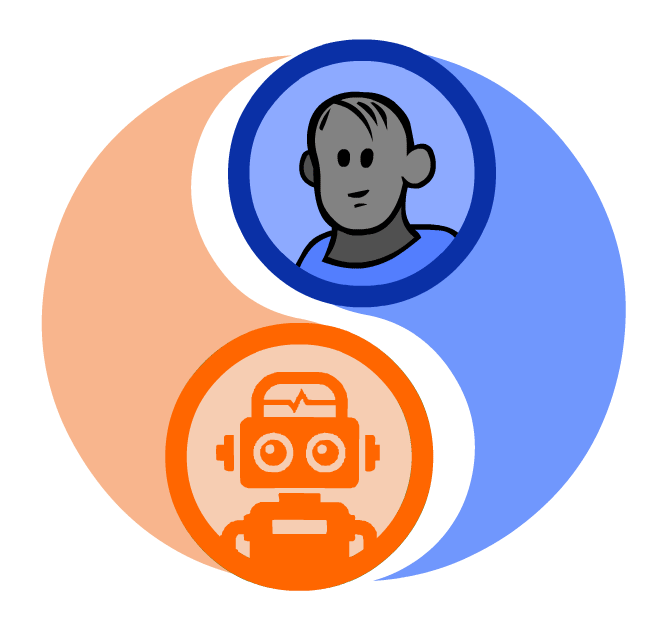AI-Powered Leadership
Fiona Passantino, early November 2023
If you’re working at a company, AI will likely transform your role, rather than eliminate it. But if you’re a freelancer who takes on certain creative tasks for organizations, your Human skills may soon be redundant. How to tell if your role is at risk and how to re-invent yourself to fit into an AI-Powered environment.
“AI is going to take away our jobs!”
If the AI transformation is expected to follow the template of other big jumps in our evolution, it will likely mean a period of uncertainty, widescale and intensive training – some structured and some in your own time – trying things out, testing what works and what doesn’t, and finally, rolling changes to what you will be doing every day.
These changes will not all be driven in a mandated, top-down way; much of the change will come from the front lines, the customer-facing, from your colleagues and from yourself as you expand into an AI-Powered capacity. We will be bathing in change, watching unfold on all sides.
Thus, if you work at a company and you’re relatively adept in your role, you will likely not you’re your job due to AI. You will be expected to learn, adapt and transform, take on more, understand the tools and be ready for more change ahead.
Internal professionals will be taking on more and more of the execution of technical tasks. We will be doing out own translation, creating our own videos, podcasts, marketing materials, design, illustrations, copywriting, music and so much more as generative models grow to outperform Humans in creative areas.
“Will I still need to hire that expensive copywriter?”
Here are a few examples of freelance jobs in danger:
Data Entry Clerks: Large-scale pattern recognition is one of the great strengths of AI. Generative Large Language Models (LLMs) are already able to automate data entry, cleaning and structuring for those who know how to set it up. ChatGPT can provide suggestions for additional fields, field collapse, renaming and expansions to offer more options later down the road. AI vision can read handwritten, or physical paper-based records, so that even the tiresome legacy work is no longer necessarily done by hand.
Transcriptionists: Speech-to-text or video-to-text technology is already well-developed and multi-lingual. APIs such as Amberscript, Assembly AI, AWS Transcribe or Deepgram can transcribe audio and video content with high accuracy.
Content and Copywriters: between ChatGPT, Bard, Pi and Claude, the AI text generative tools are constantly upgrading and feeding off new data, becoming sophisticated enough for any businesses to generate product descriptions, thought leadership articles, social posts and more. AI systems can auto-respond to structured emails and even build templates for frequently asked questions.

Customer Service Representatives: AI virtual assistants are rolling in to large companies to handle routine customer inquiries quickly, and at any time of day or night. While the tricky, complex tasks will always be a Human job, the bulk of the work can be automated. This creates less of a need for Human assistants in the first line.
Data Analysts: AI-driven analytics tools can process and analyze large datasets and provide natural language summaries and feedback for executives that they can act on easily. No need to speak or understand SQL, these tools operate on Natural Language Processing (NLP) with just a bit of practice required by the Human operator.
Social Media Managers: AI tools can schedule regular posts, analyze engagement, suggest new campaign or post ideas and generate new content. If this is well-organized by a scaffold communication tool such as Staffbase, one content type will make its way automatically to the full suite of platforms run by a company, each in its own format, with the appropriate number of characters and hashtags.
SEO Specialists: Keyword research, content optimization, link insertion and overall impact analysis by AI will reduce the need for entry-level search engine specialists.
Translators: Anyone wishing to translate written, spoken or video content from one language to another need not hire a Human translator. Whether it’s a book, a film, a podcast or visual, AI is already able to instantly provide near-native translations in just about any language. For now, for high-profile work, having a native speaker look things over at the end is still a good idea before something goes out live.
Podcast or Voiceover Speaker: this is a dying art in the corporate space if “good enough” is good enough and speed take precedence over quality. Thanks to companies like ElevenLabs or HeyGen, there is no need to hire a Human actor to voice a commercial, film, podcast or reel, in various accents, genders ages. You can use one of many AI puppets available or even clone your company CEO.
Photo Editors: color correctors, croppers, Photoshoppers, stylizers, filter artists that enhance and alter a photo of a reality-based subject.
Video Editors: the stabilizers, color graders, editors, lighting and special effects roles are already AI-based. While it’s not perfect now, these tools are only a few iterations away from cutting out the Human entirely.
Logo and Icon Designers: While high quality custom and complex design work still needs a Human hand to deliver creativity and the handmade quality, the surprising result that doesn’t look like it comes “from a can”, AI can generate a solid logo when one is needed now, that will “do the job”, and output a series of deliverables, even a style guide, color chart and range of vector assets that cover the full range of social media requirements, aspect ratios and resolutions.
Illustrators: between Midjourney, Dal-E and the range of Adobe embedded capabilities, AI can provide compelling digital illustrations, and other creative artwork in a wide range of styles, tones and textures.
UI-UX Designers: AI can generate UI-UX wireframes, layouts and offer design suggestions, as well as setting up and executing a matrix for advanced user testing. The test results can also be AI-parsed for natural language suggestions for alterations and iterative improvements.

Man vs. Machine
Creative AI artwork is still missing the warmth and immediacy that a Human provides. The topline Human artist will still be a priority for the high-end client for whom quality is essential.
The problems appears at the mid and lower ends, when speed, cost, accuracy and convenience might weigh heavier than handmade quality. Consider that the Human digital artist might spend 38 hours on a single piece, will need sleep, downtime and work for the hiring partner to arrange the admin.
The Human artist might not have time to deliver the piece when it’s needed. He might not have understood the briefing. Or, being an artist, the Human might have his own ideas about what the final work ought to look like, and insert his own vision into the assignment.
In any case, the temptation for the hiring party to leave the Human for a solid GAN might be high; and even higher as image-generating AI gets better at its craft.
Midjourney will create the Key Visual for the Food Waste Awareness campaign, and Runway will provide the digital avatar trainer for the next batch of onboarding materials. The campaigns are digital, ephemeral and not business-critical, and therefore do not warrant a Human external creative.

“Wait; I am one of those freelance professionals… how will I re-invent myself?”
The Human artist can take two paths towards his own re-invention: he could double-down on the “Human”, by producing physical, live, in-the-moment, experiential pieces that an AI can’t do (yet).
Think of the comic artist who produces the visualization of an in-person event, or the sculptor creating objects from clay. Consider the live DJ, weaving digital streams of textures, beats and riffs into a unique, creative performance that have never been heard before.
This artist would sell work that is “100% Made by Human”, whose ideas are so original and spontaneous, whose work is created and consumed live, could not possibly been generated by algorithm.
Or, the artist who becomes a conceptual creative – a storyteller, an ideas factory or creative director. Someone who orchestrates the process, floating over the execution of the actual artwork, operating many different AI generative tools and combining the results to build a storyboard, a wireframe and a rendering.
This professional would be selling a concept and the project management capability rather than the artwork itself.

“Which of these roles will stay Human?”
We will still need the photographer to take the original picture, and the prompter to craft the input (which can be an art form on its own when dealing with certain tools). We will still need the Human idea and the rough napkin sketch that captures the idea. We will still need the director, the operator, the creative manager and the brainstormer to guide the AI to the final result. But this can more and more be the communication professional who never attended art or design school, who can’t draw a stick figure if her life depended on it.
We will still need the native speaker text checker to make sure the translation is smooth and Human-sounding. We will still require a fact-checker to stamp out hallucinations and oddities. We will need the person to tie all the pieces together, to project-manage. We will need the customer service professional who has Human empathy and creativity to solve the complex problems that an AI chatbot can’t. We will need the person to tie all these pieces together and keep the overall vision alive.
But in the end, are those executionary, technical roles worth fighting for? Are we Humans made to enter text into a spreadsheet, day after day? Are we using our creative potential when we clean databases, translate text word for word from one language to another?
These tiring, tedious jobs can disappear as our wonderful new machines spit them back to us in seconds, while we take on the more interesting, unpredictable challenges that make up the 10% of the cases that require us to think outside the box.
When used correctly, AI will not take our jobs away. It will rather transform them into more creative, interesting, unexpected and interesting roles that will require a different set of skills – soft skills, such as empathy, listening, creativity, management, intuition and feeling. Communication, kindness, warmth, the ability to form connections with other Humans and take on their problems with a fresh perspective and the benefit of lived experience.

No eyeballs to read or watch? Just listen.
Re-invention of the Freelancer
If you’re working at a company, AI will likely transform your role, rather than eliminate it. But if you’re a freelancer who takes on certain creative tasks for organizations, your Human skills may soon be redundant. How to tell if your role is at risk and how to re-invent yourself to fit into an AI-Powered environment.

About Fiona Passantino
Fiona is an AI Integration Specialist, coming at it from the Human approach; via Culture, Engagement and Communications. She is a frequent speaker, workshop facilitator and trainer.
Fiona helps leaders and teams engage, inspire and connect; empowered through our new technologies, to bring our best selves to work. She is a speaker, facilitator, trainer, executive coach, podcaster blogger, YouTuber and the author of the Comic Books for Executives series. Her next book, “AI-Powered”, is coming soon.

